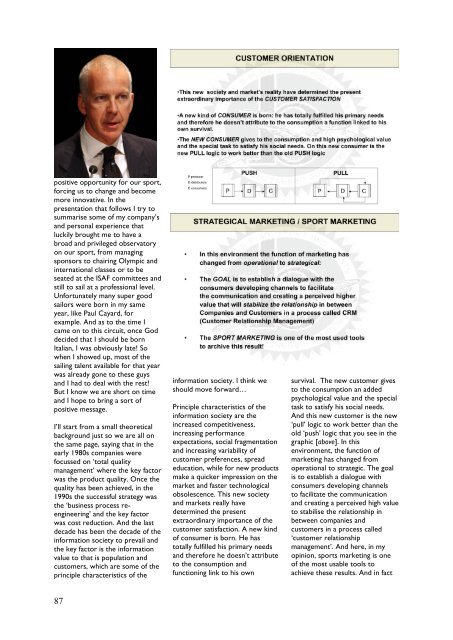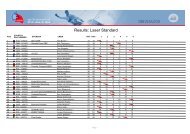WYRF transcript final v2 - The Daily Sail
WYRF transcript final v2 - The Daily Sail
WYRF transcript final v2 - The Daily Sail
Create successful ePaper yourself
Turn your PDF publications into a flip-book with our unique Google optimized e-Paper software.
positive opportunity for our sport,<br />
forcing us to change and become<br />
more innovative. In the<br />
presentation that follows I try to<br />
summarise some of my company’s<br />
and personal experience that<br />
luckily brought me to have a<br />
broad and privileged observatory<br />
on our sport, from managing<br />
sponsors to chairing Olympic and<br />
international classes or to be<br />
seated at the ISAF committees and<br />
still to sail at a professional level.<br />
Unfortunately many super good<br />
sailors were born in my same<br />
year, like Paul Cayard, for<br />
example. And as to the time I<br />
came on to this circuit, once God<br />
decided that I should be born<br />
Italian, I was obviously late! So<br />
when I showed up, most of the<br />
sailing talent available for that year<br />
was already gone to these guys<br />
and I had to deal with the rest!<br />
But I know we are short on time<br />
and I hope to bring a sort of<br />
positive message.<br />
I’ll start from a small theoretical<br />
background just so we are all on<br />
the same page, saying that in the<br />
early 1980s companies were<br />
focussed on ‘total quality<br />
management’ where the key factor<br />
was the product quality. Once the<br />
quality has been achieved, in the<br />
1990s the successful strategy was<br />
the ‘business process reengineering’<br />
and the key factor<br />
was cost reduction. And the last<br />
decade has been the decade of the<br />
information society to prevail and<br />
the key factor is the information<br />
value to that is population and<br />
customers, which are some of the<br />
principle characteristics of the<br />
information society. I think we<br />
should move forward…<br />
Principle characteristics of the<br />
information society are the<br />
increased competitiveness,<br />
increasing performance<br />
expectations, social fragmentation<br />
and increasing variability of<br />
customer preferences, spread<br />
education, while for new products<br />
make a quicker impression on the<br />
market and faster technological<br />
obsolescence. This new society<br />
and markets really have<br />
determined the present<br />
extraordinary importance of the<br />
customer satisfaction. A new kind<br />
of consumer is born. He has<br />
totally fulfilled his primary needs<br />
and therefore he doesn’t attribute<br />
to the consumption and<br />
functioning link to his own<br />
survival. <strong>The</strong> new customer gives<br />
to the consumption an added<br />
psychological value and the special<br />
task to satisfy his social needs.<br />
And this new customer is the new<br />
‘pull’ logic to work better than the<br />
old ‘push’ logic that you see in the<br />
graphic [above]. In this<br />
environment, the function of<br />
marketing has changed from<br />
operational to strategic. <strong>The</strong> goal<br />
is to establish a dialogue with<br />
consumers developing channels<br />
to facilitate the communication<br />
and creating a perceived high value<br />
to stabilise the relationship in<br />
between companies and<br />
customers in a process called<br />
‘customer relationship<br />
management’. And here, in my<br />
opinion, sports marketing is one<br />
of the most usable tools to<br />
achieve these results. And in fact<br />
87



